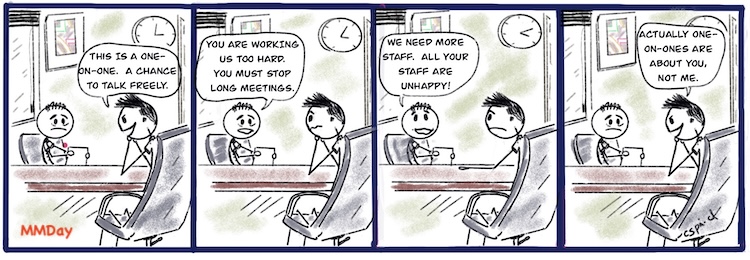Managers who have frequent one-on-ones end up with more engaged, more productive, more successful, less likely to resign direct reports according to Gallup research.
That is all the reason you need to look at having regular one-on-ones.
If you have a small number of direct reports – up to 6, then have one-on-ones weekly.
If you have more, say up to 10, then set the one-on-ones every second week.
More than 10 direct reports ? Look to restructure.

The most important understanding
The one-on-one is the employee’s meeting! It is for them and about them. It is far away from a performance review or even check-in.
How to have successful One on One’s?
It is important that the meetings are valuable to the manager and to the direct report. These meetings are not designed to specifically review the progress of their work. The purpose is to build relations, give and receive feedback, share information, discuss career development and personal development, primarily. They are not specifically for reviewing progress on current work as there must be other ways of learning what is being achieved. The one-on-one’s can focus on work if there is a specific issue that the direct report is struggling with and needs input or something has changed that needs addressing.
You might be thinking “How can I talk about career development and personal development every week?”
Obviously, you can’t.
As these meetings are about the direct reports, the manager must practice active listening. Active listening is the practice of fully concentrating, understanding, responding, and empathizing with a speaker during a conversation. It includes asking for clarifications and checking the speakers emotions using questions such as “How do feel about that?” or “How did you respond?”
The meetings must be scheduled and diarized and held by the manager as sacrosanct. They must not be considered as ”easy to cancel” meetings. So ensure that the time that you have allocated for the meeting is one that is unlikely to have multiple competitive requirements. The value of regular one-on-ones it’s so great that cancelling them frequently is very sad as it destroys their effectiveness. The time allowed for a one-on-one should be a minimum of half an hour. On occasion, if a particular discussion will take some time, extend to one hour or thereabout.
It is wise to have a template for the meeting. The template can be used for note-taking and also a prompt as to the agenda. The following are a few ideas that can be used in constructing an agenda. The importance of an item Will vary from one meeting to the next.
– Feedback exchange – this is the time to give and receive feedback
– Information sharing – this will cover things like organizational changes, new policies or other relevant updates. The direct report can share information about the projects or tasks that they were involved in.
– Challenge or problem resolution – discover and work on brainstorming solutions or offering support.
– Follow up review – this will cover any follow up from the previous meeting with actions that the manager has agreed or the direct report was to undertake. For this reason a template is an important part of the meetings.
– Career and personal development – in previous one-on-ones the manager will have discussed and agreed on personal development opportunities. This is the time to check in on progress. It is unlikely that career opportunities will be discussed at each meeting, however, the manager should be clear on the ambitions of the direct reports and when appropriate discuss them during these meetings.
– Next step and action items – if there have been any actions agreed, these are to be written down and reviewed at the end of the meeting so it records who is doing what.
Naturally, the agenda will vary on circumstances but remember the key purpose of the one-on-ones is about building relationships and supporting and coaching the direct report in their career and personal development.

Five Important practises
1. Consistency – schedule the meetings regularly and prioritize them to indicate their importance.
2. Active listening – as discussed above showing genuine interest and understanding is important in building trust.
3. Confidentiality – this must be maintained to build trust.
4. Follow-ups – it goes without saying that actions not carried out or followed up become meaningless.
5. Note-taking – whether you use paper or keep a file on your computer or phone both the manager and the direct report should keep notes of the meeting. The main notes were relate to actions but it might also be useful to make a note of information given or any agreement made.
How to view one-on-ones as a manager
Spending focused time with direct reports frequently builds a working relationship that builds trust. During the one-on-ones you might find some issues are raised that you are unaware of and can be addressed. Your interest in their development (what they are learning, what they experimenting with to improve their work, difficulties they are facing, what they need support with to develop new learning) leads to a trusting relationship in which they can raise issues safely.
Change is happening all the time it seems. Sharing information about the company or changes coming or successes makes the direct report feel like an insider. This stops rumours and gives them confidence.
Listening to a problem they are facing gives you insight into their challenges and can lead to solutions that will work.
Being innovative is a powerful tool, you might brainstorm ideas that are unique in solving problems raised. A powerful question that can lead to innovative ideas is “what if…”. For example “what if we could eliminate the need for follow ups all together?”.
Feedback on performance can also come up during one-on-ones. The purpose of feedback is linked to helping the direct report grow and develop. There is an article that addresses how to give effective feedback here: https://triumphantman.com/dealing-with-non-or-low-performers/
But, do not make them all about feedback.
Personal information. It is nice to know a bit about your fellow workers. Simple things like family, hobbies, sports, likes, dislikes, when known, transform the worker into a person with a life outside work. A manager should also be vulnerable enough to share some of their likes and dislikes, hobbies and general interests. It make a manager more human!
With practice, one-on-ones will become something you look forward to and useful ways of developing engaged employees. Your direct reports will also enjoy being in an environment in which they are clear on where they stand, have a good trusting relationship with their boss and being listened to. A win-win practice.
